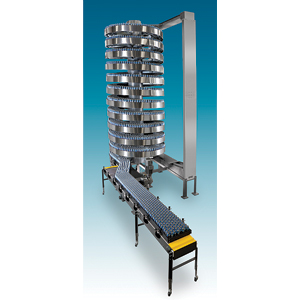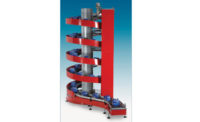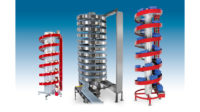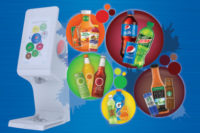Similar to the products that are shuttled across its rollers and belts, conveyor systems are working to stay on top of the trends in material handling in order tobetter serve its clientele. According to the “February 2012 Statistics” report from the Conveyor Equipment Manufacturers Association (CEMA), Naples, Fla., booked orders for the month were up 24.8 percent compared to February 2011.
Addition by subtraction

|
| Ryson International offers a lineup of spiral conveyors, which can handle high production and line speeds while saving on floor space, the company says. |
Among the numerous trends taking place in the beverage industry, reducing the amount of packaging, whether primary, secondary or both, has added an important challenge for conveyor systems.
“The reduction of secondary and tertiary packaging materials has been most prevalent in the elimination of corrugated trays for shrinkwrapped packages to reduce packaging costs,” says Tim Krueger, vice president and general manager of Arrowhead Conveyor Corp., Oshkosh, Wis.
To accommodate the reduction in secondary packaging, Krueger says, Arrowhead updated its current products to enhance product transferring, case turning, dividing and converging devices to handle innovations in case styles.
“This change has increased the demand for low and/or zero back pressure accumulation systems,” he says. “Arrowhead offers low back pressure conveyors through the use of roller top modular belts. For zero pressure applications, we utilize modular lift zones, which raise the product off the belt, eliminating back pressure and scuffing of the product.”
Reducing packaging materials not only lessens overall packaging costs, it also can be important for a warehouse’s sustainability efforts.
“Use of ‘eco-friendly’ bottle materials and thinner containers along with removal of corrugated bottom pads are particularly a frequent concern when designing conveyor lines,” says J. Bryan Boyce, product manager of conveyor products for Intelligrated Inc., Cincinnati.
Reduction in packaging content, such as lightweight PET bottles wrapped in shrink packaging, has presented some challenges; however, Intelligrated has worked to ensure successful transitions between conveyors, and that the proper steps are taken to ensure packages are conveyed without skewing or stalling, Boyce says.
The elimination of pads and trays also has presented some challenges when it comes to roller conveyors, says Dennis Scates, beverage industry account manager for Intralox LLC, Harahan, La.
“If you think about the contact surface [and] the bottom of a package as it relates to a conveyor system, it’s really what’s touching the top of the conveyor,” Scates says.
He adds that with the removal of the tray or pad, instead of cardboard or fiberboard coming in contact with the conveyor, the base of the product now comes into contact with it, which could consist of containers that do not have a flat surface.
“If you walk into an older beverage production line, especially when you get back into the packaging side, more often than not you’re going to find roller conveyors transporting cases typically from a case packer to a palletizer … and you can’t convey [those] shrinked bundles effectively on that,” says Scott Shannon, global team leader of brew, beverage and consumer goods with Intralox.
To accommodate shrink packaged bundles, Intralox offers its S7000, which is utilized as switches, laners, merges and palletizer in-feed systems to handle shrink-only bundles.
“Its dense roller pattern and ability to switch, merge and/or turn cases, ranging from 36-packs down to six-packs, in one operation provides our customers with the added flexibility to run these products within the existing footprint of the production line,” says Danny Bujold, beverage industry account manager for Intralox.
Vertically inclined
Because of the set amount of square footage in a warehouse, capitalizing on the amount of space in a facility remains front-of-mind for beverage-makers. For conveyor systems, one of those space savers is the use of spiral conveyors.
“Historically, [requests] have always been after products have been put into cases and moving cases from case packers toward palletizing areas just to get product up off of the production floor and taking it up to the overhead conveyor,” says Phil Miller, president of AmbaFlex, Bedford, Texas. “… These days, we’re getting more inquiries for beverage bottles and cans — individual can and bottle accumulation — so we’re further into the process side.”
Miller adds that it is becoming more standard in the industry to use spiral conveyors for accumulation and buffering of production lines. Whether in mass flow or individual flow, he says, spirals can be used in de-palletizing as well as feeding pasteurizers.
“It’s becoming more prevalent in the [production] process as opposed to handling finished cartons and cases on the back end of a conveyor system of a production line,” he says.
To accommodate this growing trend, AmbaFlex’s product family includes its SpiralVeyor lineup, including its SVM model for individual bottles and cans, which is based on multiple-track chain belt technology for both single lane and mass flow.
The SVM can be useful if problems persist with other equipment throughout the production line, Miller says. Allowing filler production to continue, the SVM can buffer and accumulate product until everything is ready downstream, he adds.
Just like all other conveyor systems, spiral conveyors must meet the demands for higher speeds.
Previously, elevators offered a relatively slow solution to conveying products, says Ole Rygh, president of Ryson International, Yorktown, Pa. Today, spiral conveyors have the ability to keep up with higher line speeds by conveying change elevations at very high production speeds, while taking up a fraction of the floor space, he adds.
“As the lines increase in speed, [they] also tend to take up more space because there are more features being put into it and they’re running out of space, so when we can do change elevations in a small footprint that is something that [the beverage industry] is looking for,” Rygh says.
In addition to faster speeds and higher throughput, Rygh says that companies also are looking for ease of changeover and minimal downtime.
“The changeover is something that [beverage warehouses] like to have a minimum of because it takes downtime,” he says. “… Looking at our equipment, we don’t require any changeover and our equipment is modular, [so] what we’re finding out in many packaging and bottling lines is as the lines change they like to have the ability to reconfigure the equipment in their plants.”
Adjusting responsibilities
SKU proliferation coupled with product branding and consumer demands continue to impact the conveyor market.
“We are seeing a wider array of quantities and packaging like four-packs, six-packs, eight-packs and 12-packs,” says Chris Glenn, director of product technology for Hytrol Conveyor Co. Inc., Jonesboro, Ark. “We are also seeing the larger sizes like what we refer to as ‘bag-in-the-box’ type packages for drink mixes.”
With a growing array of products and packages, flexibility also remains important. Hytrol offers its EZLogic zero pressure accumulation system, which allows for customization of zone lengths to specific packaging sizes to maximize conveyor density, Glenn says.
“Our systems also provide the flexibility of belted accumulation in lieu of rollers only,” he says. “When using belted conveyors, you have more flexibility to handle the different packaging sizes and shapes than when using rollers only.”
Intelligrated also takes on a mixed approach with its conveyors offering both traditional rollers and modular plastic belt-style conveyors.
“The past trend of using ‘non-roller’ conveyors exclusively for post-packer conveyance has evolved to what could be considered ‘hybrid’ systems,” Intelligrated’s Boyce says. “Most systems are using a combination of traditional roller conveyors and modular plastic belt-style conveyors in the same line configurations.” BI




